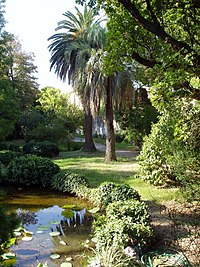
A botanical garden or botanic garden[nb 1] is a garden with a documented collection of living plants for the purpose of scientific research, conservation, display, and education.[1] It is their mandate as a botanical garden that plants are labelled with their botanical names. It may contain specialist plant collections such as cacti and other succulent plants, herb gardens, plants from particular parts of the world, and so on; there may be glasshouses or shadehouses, again with special collections such as tropical plants, alpine plants, or other exotic plants that are not native to that region.
Most are at least partly open to the public, and may offer guided tours, public programming such as workshops, courses, educational displays, art exhibitions, book rooms, open-air theatrical and musical performances, and other entertainment.


Botanical gardens are often run by universities or other scientific research organizations, and often have associated herbaria and research programmes in plant taxonomy or some other aspect of botanical science. In principle, their role is to maintain documented collections of living plants for the purposes of scientific research, conservation, display, and education, although this will depend on the resources available and the special interests pursued at each particular garden. The staff will normally include botanists as well as gardeners.
Many botanical gardens offer diploma/certificate programs in horticulture, botany and taxonomy. There are many internship opportunities offered to aspiring horticulturists. As well as opportunities for students/researchers to use the collection for their studies.
Cite error: There are <ref group=nb> tags on this page, but the references will not show without a {{reflist|group=nb}} template (see the help page).
- ^ EPIC. "Botanic Gardens and Plant Conservation". Botanic Gardens Conservation International. Retrieved 26 November 2022.